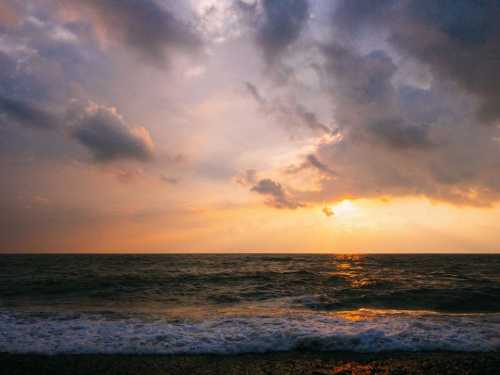
Beyond its alluring beauty and popularity as a favorite recreation area, the Black Sea is a unique ecosystem whose dynamic currents, unusual depths, and chemical composition shape its true, complex character that continues to reveal its secrets to scientists.
The history of the Black Sea stretches back millions of years, from the ancient Tethys Ocean to its periods as a vast freshwater lake, the Pontic. Its current form is the result of geological events and significant sea level changes that have radically affected its biodiversity and water balance.
About 8,000 years ago, the dramatic opening of the Bosporus Strait allowed the salty waters of the Mediterranean Sea to rush into the then freshwater Pontic Lake. This influx, combined with the constant influx of freshwater from large rivers, formed a unique bistratification: a lighter, less salty, and oxygenated upper layer that is virtually immiscible with a denser, highly saline, and anaerobic lower layer. This stable bilayering is its defining oceanographic feature.
The dominant dynamic feature of the Black Sea is the so-called Main Black Sea Current, which moves counterclockwise along its perimeter, forming large-scale water circulations, enhanced by the Coriolis effect. Within this ring, especially in the northwestern part, powerful eddies and cyclic structures form, which can reach a diameter of more than 50 kilometers and play a key role in the redistribution of heat, salt and nutrients.
Wind plays a significant role in moving the upper water masses and forming smaller currents, but deep-sea movements are also determined by the bottom relief and the Coriolis effect. Near the western coasts, where certain wind conditions prevail, upwelling often occurs – the rise of cold, nutrient-rich waters from the depths, which is vital for maintaining the high biological productivity of the region, despite the general stratification of the sea.
Along with large-scale currents, the Black Sea, like other coastal waters, has local “tugs” or reverse currents that form when waves recede from the shore due to uneven bottom conditions. These narrow but powerful currents can pose a serious danger to swimmers, and the key advice is not to try to swim against the current, but to move parallel to the shore to get out of the danger zone.
Despite myths about mysterious disappearances, the central Black Sea is not the “Bermuda Triangle”; on the contrary, it is an important transit corridor for international shipping. Although hypotheses about potential methane emissions from the seabed exist, they do not confirm theories about mass unexplained shipwrecks, but only emphasize the unique geological activity of the region.
Researching the depths of the Black Sea is exceptionally difficult due to extreme pressure, low temperatures and a complete lack of oxygen. However, it is these harsh conditions, especially the hydrogen sulfide environment, that create a unique phenomenon: they effectively preserve organic materials and wood from sunken ships, turning the seabed into a true archive of maritime history, where finds are preserved in an almost pristine state, unlike in other seas.
Storms in the Black Sea can indeed be intense and fleeting, often triggered by sharp changes in atmospheric pressure and cyclonic activity that form over its waters. However, modern meteorological models and satellite data make them predictable, allowing both military and commercial vessels to successfully avoid or withstand them thanks to advanced navigational technology.
With a maximum depth exceeding 2,200 meters in the central basin, the Black Sea is one of the deepest inland seas in the world, exceeding many open seas in this respect. Its average depth is also significant, creating a significant volume of deep, anoxic waters.
The choice of sea routes in the Black Sea is not dictated by secret prohibitions, but solely by logistical and economic expediency. Vessels navigate mainly along established corridors that connect ports, provide access to navigation services, pilotage support, shelter in bad weather, and optimal conditions for refueling and repairs, which increases both safety and efficiency of transportation.
Unlike many other seas, the Black Sea is characterized by an almost complete absence of natural islands in its central part, a result of its geological history as a deep-sea basin without significant tectonic uplift. There are only a few very small islands near the coast, such as Zmiiniy.
Major fish populations, such as anchovy and sprat, are predominantly concentrated in the coastal shelf zones of the Black Sea. This is due not only to the greater availability of sunlight and the influx of nutrients from rivers and upwelling, but also to the fact that the oxygen layer suitable for most marine organisms is limited to the upper 100-200 meters, creating a natural biological “ceiling”.
The hydrological bistratification of the Black Sea is one of the most dramatic in the world: a relatively thin surface layer, saturated with oxygen, supports most complex marine life. However, already at a depth of 100-200 meters, a huge, oxygen-free “hydrogen sulfide zone” begins, covering about 90% of the water volume. In this environment, exclusively anaerobic bacteria thrive, which, decomposing organic matter, actively produce hydrogen sulfide (H2S), making these depths unsuitable for higher life forms.
It is this unique, almost completely anaerobic deep-sea system of the Black Sea that makes it a priceless natural archive. Due to the absence of oxygen and any destructive organisms (which require oxygen), sunken ships and archaeological artifacts trapped in the hydrogen sulfide layer are preserved in remarkably good condition, offering unparalleled opportunities for the study of maritime history and culture.





